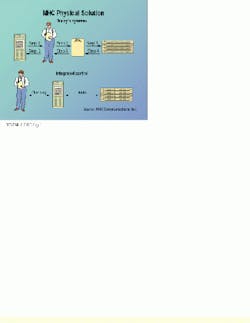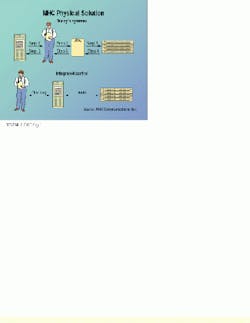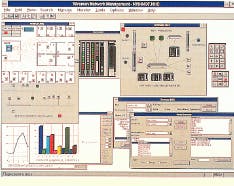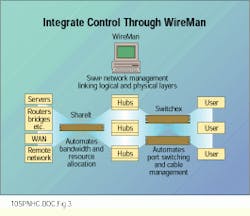Automated cable management through crossconnect switch integration can bring global enterprise network management to a higher level, by putting "intelligence" in the physical layer.
Stephane Namoko,
NHC Communications Inc.
Ongoing management of the physical layout of an enterprise network is no small job. Cable management software can help, but is generally limited to a passive supporting role. However, by combining next-generation cable management software with remotely controllable crossconnect switching, many common tasks can be greatly simplified, and a new range of interesting possibilities opens up.
Typically, cable management [software] systems (CMS) are designed to document corporate cabling systems and simplify network management and troubleshooting procedures. The CMS provides a graphical representation of the physical network layout. This, in turn, is linked to a database engine. In the event of a fault, the system allows automatic generation of work orders or trouble tickets. Ultimately, however, actual changes must still be performed manually, and a technician must go to the wiring closet and reconnect patch cords or jumper wires.
Working down from the abstract network level, network management systems (NMSs) can analyze, monitor and optimize the logical network. Until now, however, cable- and network-management systems have remained separate worlds, although they share a common environment: the physical cabling system.
To allow working more closely with the cabling system, NHC has developed WireMan advanced cable management software. This next-generation software combines the best features of cable- and network-management systems. The NMS allows control of any device that is compliant with simple network management protocol (Snmp) and has a management information base (MIB), but the software goes beyond traditional cable management systems. When used with an electronic crossconnect switch, it can perform all moves, adds and changes either locally or remotely.
When changes are required -- because of a fault or simply for routine reconfiguration -- the user can usually implement them from a central control console, using a point-and-click mouse interface. Physical connections in the network are automatically reconfigured by the switch. This new level of automation brings "intelligence" to the physical layer, and thereby brings expanded flexibility to the task of network and cabling structure administration. Security and fault-tolerant redundancy can be improved, and a new range of applications, including remote-branch management and remote video surveillance, become feasible.
Communicating with the hardware
Having a two-way dialog established between the CMS and the switch has numerous advantages, which are easy to see in a typical scenario. Suppose, for example, that a person within the enterprise is moving from one office to another. Using today`s systems to perform the required network change, several steps must be performed, probably by more than one person:
- Get data from the information system (database, spreadsheet or paper files).
- Based on this data, the administrator creates a work order.
- In most cases, you will have to check existing connections, as the database may not be up-to-date.
- The technician goes to the telecommunications closet and changes the patch cord connections.
- After the move has been implemented, the user must update the database to preserve system efficiency.
Obviously, this is a complex and laborious procedure, with numerous opportunities for hidden pitfalls. For example, in certain areas -- New York City, for example -- union authorization is required before you access the wiring closet. Also, updating the database is a step that may often be skipped -- for example, when other changes must be implemented at once -- leaving the potential for future difficulties.
Compare how easy and efficient it becomes when using an intelligent crossconnect switch with appropriate software. The procedure is simple. The administrator uses the CMS software from the workstation. Running the graphical database either stand-alone or over the network, the user manages the cabling system with a point-and-click of the mouse. The software automatically reconfigures the network by controlling the crossconnect switch and instantly updating the database. There is no need to enter the wiring closet.
To move a person from one office to another, the administrator accesses a graphical representation of the floor plans, showing all offices, outlets, personal computers (PCs) and telephones. Next, he or she simply selects the icon corresponding to the employee`s PC and drags it to its new location. After checking the database, the software will issue the proper commands to the crossconnect switch over the network (in-band). The new outlet is activated within a matter of seconds.
The advantages of the latter approach are fairly obvious: Changes can be implemented instantly with little effort. Reducing the labor involved brings an immediate, substantial cost savings. Even greater savings come from the reduced potential for errors. In a February 1996 Cable Management System Overview by Datapro Information Services Group (Delran, NJ), it is estimated that 43% of network faults are directly related to the physical layer. Because the CMS system effects changes automatically at this level, the potential for failure is virtually eliminated. In addition, the database is automatically updated after each change, so the possibility of later confusion and disruption is also minimized.
The result is that network downtime is reduced directly during any moves, adds or changes, and indirectly by elimination of related faults. Using this type of approach will typically produce a return-on-investment ranging from one to two years for local configurations, and less than 10 months when dealing with remote-branch management configurations--by simply eliminating manual time, travel and recording systems.
Of course, faster return-on-investment is only one of the benefits. Fully automating moves of office cabling and equipment in a managed cable world opens up opportunities for providing new services, just as automated private branch exchanges did when they supplanted operator-connect telephone systems years ago.
Automating cable management becomes even more valuable when applied to remote-branch management. For organizations with multiple branch offices, coping with network and cable management at remote sites is a major cost. In many cases, the workload is not enough to justify maintaining a local technician at each location. And the only alternative is to send a technician from the main office each time a problem occurs or system modifications are required. The downtime, travel and lodging add costs that make cabling changes prohibitively expensive.
With electronic crossconnect switches located at remote branches, however, information system departments can directly manage external facilities from the main office. The same control software, such as WireMan, can be used to integrate management of the entire wide-area network (WAN) configuration.
How it works
The key to the operation of intelligent network switching is the WireMan software, an advanced, Windows-based application that offers a substantial back-end capability. For example, WireMan provides integrated Snmp network-management functions, monitoring of MIB values, network diagnostics, network database management and full reporting options. End-user devices ranging from phones, cameras and printers can be supported. For Snmp operation, an Snmp proxy agent is required at the switch. This is a separate module, essentially a translator from Snmp to RS-232, which receives commands from the network in Snmp format and translates them into RS-232 commands that can be processed by the switch. This allows the switch to be reconfigured automatically according to Snmp traps and alarms.
Our Snmp controller currently supports Ethernet and 10Base-T, and plans are in place that it will support token ring at the end of this year. For maximum flexibility, the switch should be protocol-independent. This capability has been central to the company`s development of StakiT, ShareIt and Switchex switches, which support LAN protocols including Ethernet, token ring, AS400, 100VG AnyLAN and ATM 25, as well as RS-232 and analog-video and digital-voice signals. Most common connector types are supported, including RJ-45, RJ-21-Telco and ATT110. Switches are available in several matrix sizes, and modules can be tied together to form larger matrices.
This flexibility allows virtually every type of signal within the enterprise to be routed automatically by the same central control software. Beyond making the existing network infrastructure easier to manage, it also allows development of some interesting new applications.
As the intelligently switched network can be reconfigured dynamically in response to planned events, equipment failures, or network performance changes, MIS managers now have a tool to manage their systems proactively. However, this same management capability can be used to implement a range of new applications not previously feasible.
One application that has been evolving at NHC is the use of crossconnect switches to pass analog video in parallel with the digital network infrastructure, exploiting unused lines that are available in most cable installations. For example, video surveillance is an obvious beneficiary of this technology. Remote video cameras can be monitored from a central location, using a PC equipped with an appropriate analog-video adapter card. Costs are reduced to about 50% of a traditional video-surveillance system that is based on dedicated analog cabling.
Videoconferencing and on-demand training are also being considered as desktop video applications. In addition, WireMan`s integrated Snmp capabilities allow software to receive alarms and to gather Snmp statistics from network devices. This leads to new opportunities; for example, a faulty device can be isolated instantly from the network, and critical devices, such as servers, can be rerouted automatically to a secondary network link in the event of hub failure.
These ideas form the basis of a project being conducted by NHC to implement a complete, downtime-free network configuration. All equipment is set up in such a way that a redundant communication path is always available for each device.
The best way to prevent hackers from accessing your network is to "pull the plug." Without physical connections, obviously, there is no way to enter a system. Cable management software connected to intelligent switches makes this easy to accomplish. Scenarios can be predefined in the software to physically disconnect all users from the network after business hours--or at any other time that maximum security is required.
Automatic configuration control using electronic switches allows a number of other cost-saving applications. Expensive equipment such as LAN and WAN analyzers can be shared easily among network segments, with single devices allocated remotely to any desired segment. Remote switching also allows more-efficient network segmentation and load balancing.
The next step in reducing complexity and costs of enterprise-network management is to enable scalable and interoperable management solutions. NHC is already looking at Web-based enterprise management -- that is, cable management via Internet Web browser software. This promises to bring an even higher degree of control and convenience to the once thorny task of cabling system management.
Comparing today`s CMS systems (top) with integrated control (bottom) shows that, to implement a move, add or change, manual patching takes six steps, but two-way communication between the CMS and the switch requires only one step.
The graphical user interface is completely configurable and lets users move physical network resources simply by dragging and dropping icons on a floor plan or schematic network diagram.
Advantages of integrating logical and physical layers using Snmp network management include automated resource allocation and port switching.
Stephane Namoko is product manager, software systems, NHC Communications Inc., Mount Royal, QC, Canada.



